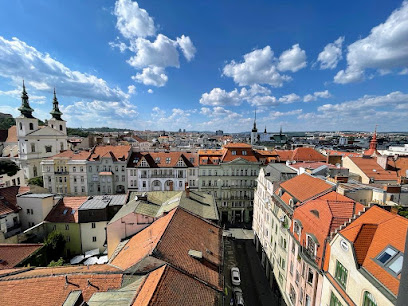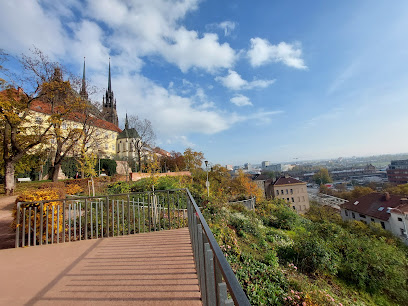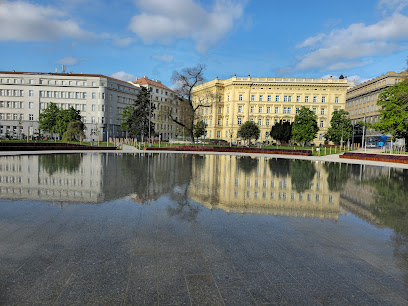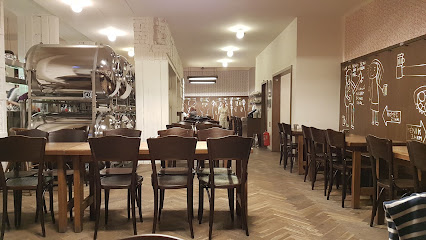
Brno-Stred: The Heartbeat of South Moravia
Discover Brno-Stred: A vibrant blend of history, culture, and culinary delights in the heart of Brno, Czechia.
Nestled in the vibrant city of Brno, Brno-Stred is a dynamic blend of modernity and history. This central district is the cultural and historical heart of Brno, making it a must-visit for any traveler. The area is home to some of the city's most iconic landmarks, including the stunning Špilberk Castle. This fortress, with its rich history dating back to the 13th century, offers panoramic views of the city and a peek into the region's past. Wander through the cobblestone streets and you'll find yourself surrounded by impressive architecture from various eras. Gothic, Baroque, and modernist buildings stand side by side, creating a picturesque urban landscape. Don't miss the Cathedral of St. Peter and Paul, a gothic masterpiece that dominates the skyline. Its twin spires are a symbol of Brno and offer another vantage point to see the city from above. Brno-Stred is also a hub for culinary delights. From traditional Czech pubs to contemporary restaurants, foodies will find plenty to savor. Try local specialties like 'svíčková' or indulge in a selection of Moravian wines. The district's vibrant café culture is perfect for those looking to relax and people-watch. Visit the bustling Zelný trh (Cabbage Market) for fresh produce, local crafts, and a taste of daily life in Brno. Art and culture enthusiasts will feel right at home in Brno-Stred. The district hosts numerous museums, galleries, and theaters, including the Moravian Gallery and the Brno City Museum. The annual Ignis Brunensis fireworks festival and Brno Biennial are just a few of the events that highlight the area's rich cultural calendar. Whether you're exploring historic sites, enjoying local cuisine, or immersing yourself in the arts, Brno-Stred offers a captivating experience for every traveler.
Local tips in Brno-Stred
- Visit Špilberk Castle early in the day to avoid crowds and enjoy the best views of Brno.
- Carry cash for small purchases at local markets and traditional pubs, as not all places accept cards.
- Dress in layers; the weather can be unpredictable, especially in spring and autumn.
- Use public transport or walk to explore the neighbourhood; parking can be challenging in the city center.
- Check local event calendars for festivals and cultural events happening during your visit.
Iconic landmarks you can’t miss
Špilberk Castle
Discover the rich history and breathtaking views at Špilberk Castle, a must-visit tourist attraction in Brno, Czech Republic.

Náměstí Svobody
Explore Náměstí Svobody in Brno, where history and modernity blend seamlessly in a vibrant cultural plaza filled with events and local charm.

Astronomical Clock
Discover Brno's Astronomical Clock, an exquisite blend of art and science, illuminating the rich historical tapestry of this vibrant city.

Old Town Hall - Tourist Information Centre
Discover Brno's Old Town Hall, a historical landmark blending rich heritage with stunning views and vibrant local culture, perfect for every tourist's exploration.

Moravian square park
Explore Moravian Square Park - a serene green oasis in Brno, perfect for relaxation, cultural immersion, and picturesque strolls.

Denis Gardens
Explore the tranquility and beauty of Denis Gardens in Brno, a perfect blend of nature and culture with panoramic views and rich history.

Marian Plague Column
Discover the Marian Plague Column in Brno, a breathtaking baroque monument honoring the resilience of the city and its people amidst the plague's devastation.

Fortification Wall Circuit
Discover Brno's Fortification Wall Circuit, a stunning historical landmark that showcases the city's rich history and breathtaking views.

Palace of the Abbot of the Žďár Monastery
Explore the exquisite architecture and rich history of the Palace of the Abbot of the Žďár Monastery in Brno, a captivating landmark for all travelers.

Year Fountain
Discover the Year Fountain in Brno: a stunning blend of art, history, and serene beauty that captures the heart of this vibrant city.

Unmissable attractions to see
Astronomical Clock
Experience the captivating Astronomical Clock in Brno, a blend of history, art, and culture in the heart of the city.

Moravian square park
Experience the charm of Moravian Square Park in Brno, a vibrant city park that blends nature, art, and community events.

Brno Observatory and Planetarium
Unveil the secrets of the universe at Brno Observatory and Planetarium, where celestial wonders await in a stunning cultural and educational setting.

Kostnice u sv. Jakuba
Explore the haunting beauty of Kostnice u sv. Jakuba, Brno's unique ossuary that reveals the city's captivating history and cultural significance.

Moravian Museum
Immerse yourself in the rich history and culture of Moravia at the Moravian Museum, a must-visit attraction in Brno.

Fortification Wall Circuit
Discover the historic Fortification Wall Circuit in Brno, a breathtaking journey through the city's ancient defenses with stunning views and rich heritage.

Essential places to dine
Monte Bú restaurant a steakhouse
Experience exquisite steaks and fine wines at Monte Bú restaurant in Brno – where culinary excellence meets warm hospitality.

Lokál U Caipla
Experience authentic Czech flavors and local brews at Lokál U Caipla in Brno - a culinary haven for tourists seeking memorable dining.

Buddha
Discover authentic Indian cuisine at Buddha in Brno - A delightful culinary journey awaits you with vibrant flavors and warm hospitality.

Restaurace Jakoby
Experience the rich flavors of Czech cuisine at Restaurace Jakoby in Brno - where tradition meets innovation.

Borgo Agnese
Experience exquisite Mediterranean flavors at Borgo Agnese in Střed, where culinary artistry meets warm hospitality.

Pavillon Steak House
Discover the exquisite taste of premium steaks at Pavillon Steak House in Brno - where culinary excellence meets inviting ambiance.

Restaurace Špalíček
Discover authentic Czech cuisine with a modern twist at Restaurace Špalíček in the heart of Brno.

Vittorio Restaurant
Experience authentic Mediterranean flavors at Vittorio Restaurant in Brno – where every meal is a celebration of taste.

Palazzo Restaurant
Discover exquisite Mediterranean and Italian cuisine at Palazzo Restaurant in Brno – a must-visit culinary destination!

Siesta Lobby & Wine Restaurant
Experience the rich flavors of Czech cuisine at Siesta Lobby & Wine Restaurant in Brno, where exceptional food meets an impressive wine selection.

Markets, malls and hidden boutiques
Galerie Vaňkovka
Discover an array of shopping, dining, and entertainment options at Galerie Vaňkovka, Brno's premier shopping mall for tourists.

Flying Tiger Copenhagen
Explore a world of creativity and fun at Flying Tiger Copenhagen, the ultimate gift shop in Brno-střed for unique finds and whimsical treasures.

Eagle Shopping Gallery
Discover the perfect blend of shopping, dining, and entertainment at Eagle Shopping Gallery in Brno, the ultimate retail experience.

Metalshop Store Brno
Explore Metalshop Store Brno: Your one-stop shop for unique metal clothing, accessories, and footwear in the heart of Brno.

PLACE STORE
Explore PLACE STORE in Brno for unique gifts, local crafts, and delightful souvenirs that encapsulate the spirit of Czech culture.

Centrum Department store
Immerse yourself in the vibrant atmosphere of Centrum Department Store, Brno's premier shopping mall blending modern retail with historical charm.

Textile House Vintage Shop
Explore the charm of sustainable fashion at Textile House Vintage Shop in Brno, where unique second-hand treasures await every fashion lover.

Dvorek store
Explore Dvorek Store in Brno for unique gifts and local treasures that embody the city's rich culture and artistry.

Modest shopping centre kiirua
Explore Modest Shopping Centre Kiirua in Brno-střed for a unique retail experience with local and international brands in a vibrant atmosphere.

Muse Boutique
Explore Muse Boutique in Staré Brno for unique fashion and artisanal gifts that capture the essence of local style and creativity.

Essential bars & hidden hideouts
The bar that doesn't exist
Experience the enchanting atmosphere of Brno's unique bar, where creative cocktails and gourmet burgers come together in a whimsical setting.

ALOHA
Discover Aloha in Brno: a lively bar and coffee shop offering a perfect blend of relaxation and social atmosphere for every visitor.

Whiskey Bar, který neexistuje
Experience the charm of Whiskey Bar, který neexistuje in Brno, where whiskey enthusiasts find a cozy haven with exceptional drinks and warm hospitality.

Little Big Bar
Experience the vibrant nightlife of Brno at Little Big Bar, where craft cocktails and lively atmosphere meet for an unforgettable evening.

Atelier Bar & Bistro
Explore the culinary delights of Atelier Bar & Bistro in Brno, featuring modern international cuisine and artfully crafted cocktails in a vibrant setting.

SHOT BAR
Experience Brno's nightlife at SHOT BAR, where creativity meets fun in a vibrant setting perfect for socializing and enjoying unique cocktails.

ROTOR Bar
Discover the vibrant atmosphere of ROTOR Bar in Brno, where expertly crafted drinks and a lively ambiance create the perfect nightlife experience.

Endless fun
Experience the vibrant nightlife of Brno at Endless Fun, your go-to bar and restaurant for delicious food and creative cocktails.

Cohiba Club Conti
Discover the elegance of Cohiba Club Conti, Brno's finest bar offering a sophisticated selection of drinks and stylish atmosphere.

Runway Bar
Discover Brno's nightlife at Runway Bar, a chic cocktail destination blending comfort and creativity in every drink.

Local Phrases
-
- HelloAhoj
[ahoy] - GoodbyeNa shledanou
[na skledanou] - YesAno
[ah-no] - NoNe
[neh] - Please/You're welcomeProsím
[pro-seem] - Thank youDěkuji
[dyeh-koo-yi] - Excuse me/SorryPromiňte
[pro-meen-tye] - How are you?Jak se máte?
[yak se mah-teh] - Fine. And you?Dobře. A vy?
[doh-breh. ah vee] - Do you speak English?Mluvíte anglicky?
[mloo-vee-teh ahn-gleet-skee] - I don't understandNerozumím
[neh-roh-zoo-meem]
- HelloAhoj
-
- I'd like to see the menu, pleaseRád bych viděl menu, prosím
[rahd bikh vee-dyehl meh-noo, pro-seem] - I don't eat meatNejím maso
[ney-eem mah-soh] - Cheers!Na zdraví!
[na zdra-vee] - I would like to pay, pleaseChtěl bych zaplatit, prosím
[khtyel bikh zah-pla-teet, pro-seem]
- I'd like to see the menu, pleaseRád bych viděl menu, prosím
-
- Help!Pomoc!
[poh-mohts] - Go away!Jdi pryč!
[ydee preetch] - Call the Police!Zavolejte policii!
[za-vo-leh-yteh poh-lee-tsee] - Call a doctor!Zavolejte lékaře!
[za-vo-leh-yteh leh-kar-zheh] - I'm lostZtratil jsem se
[ztra-teel yehm seh] - I'm illJsem nemocný
[yehm ne-mohts-nee]
- Help!Pomoc!
-
- I'd like to buy...Chtěl bych koupit...
[khtyel bikh koh-peeht...] - I'm just lookingJen se dívám
[yehn seh dee-vahm] - How much is it?Kolik to stojí?
[ko-leek toh stoh-yee] - That's too expensiveTo je příliš drahé
[toh yeh pree-leesh drah-heh] - Can you lower the price?Můžete snížit cenu?
[moo-zheh-teh snee-zheet tseh-noo]
- I'd like to buy...Chtěl bych koupit...
-
- What time is it?Kolik je hodin?
[ko-leek yeh hoh-deen] - It's one o'clockJe jedna hodina
[yeh yehd-nah hoh-dee-nah] - Half past (10)Půl jedenácté
[pool yeh-deh-naht-seh] - MorningRáno
[rah-noh] - AfternoonOdpoledne
[od-po-led-neh] - EveningVečer
[veh-chehr] - YesterdayVčera
[v-cheh-rah] - TodayDnes
[dnes] - TomorrowZítra
[zee-tra] - 1Jedna
[yehd-nah] - 2Dva
[dvah] - 3Tři
[tree] - 4Čtyři
[cht-yee-ree] - 5Pět
[pyet] - 6Šest
[sh-est] - 7Sedm
[sdeem] - 8Osm
[oh-sm] - 9Devět
[deh-vyet] - 10Deset
[deh-set]
- What time is it?Kolik je hodin?
-
- Where's a/the...?Kde je...
[kdeh yeh] - What's the address?Jaká je adresa?
[yah-kah yeh ah-deh-srah] - Can you show me (on the map)?Můžete mi ukázat (na mapě)?
[moo-zheh-teh mee oo-kah-zaht (nah mah-peh)] - When's the next (bus)?Kdy jede další (autobus)?
[kdee yeh-deh dah-lshee (ow-toh-boos)] - A ticket (to ....)Jedno jízdenku (do ...)
[yed-noh yeez-dehn-koo (doh)]
- Where's a/the...?Kde je...
History of Brno-Stred
-
Brno-Stred, as part of the historical city of Brno, has roots that trace back to the 13th century. The establishment of the city was influenced by its strategic location at the crossroads of important trade routes in Central Europe. The original settlement around the Brno Castle began to flourish, leading to the development of urban infrastructure and the establishment of key trade activities.
-
The late Middle Ages saw Brno-Stred evolve significantly, particularly during the Gothic and Renaissance periods. The construction of St. Peter and Paul Cathedral and the expansion of the city walls during the 14th and 15th centuries reflected the city’s growing importance. The Renaissance brought about cultural prosperity, evidenced by the construction of beautiful palaces and the flourishing of arts and sciences.
-
The Thirty Years' War (1618-1648) had profound effects on Brno-Stred, leading to periods of occupation and economic hardship. However, the war also resulted in the strengthening of the city’s fortifications, particularly around the Špilberk Castle, which became a symbol of resilience. The aftermath of the war prompted a period of reconstruction and revitalization in the 17th century.
-
The 19th century marked a significant transformation in Brno-Stred with the onset of industrialization. Brno developed into a major industrial center, particularly noted for its textile production and engineering sectors. The establishment of the railway in the 1840s further enhanced its economic landscape, integrating Brno more closely with other European cities and facilitating trade.
-
Following the establishment of Czechoslovakia in 1918, Brno-Stred became a focal point for national identity, culture, and education. The interwar period saw the construction of modernist architectural landmarks, contributing to Brno's reputation as a hub of progressive design. The city's cultural life thrived with the establishment of theaters, galleries, and educational institutions.
-
The post-World War II era brought significant changes to Brno-Stred as Czechoslovakia fell under communist rule. The city underwent extensive urban planning, resulting in the construction of large housing estates and the development of public amenities. This period also saw efforts to preserve historical sites amidst rapid urban development.
-
Since the Velvet Revolution in 1989, Brno-Stred has experienced a cultural renaissance, marked by a resurgence in local arts, music, and gastronomy. The neighborhood has become increasingly popular with both locals and tourists, who are drawn to its historical sites, vibrant cultural scene, and numerous festivals that celebrate its rich heritage.
Brno-Stred Essentials
-
Brno-Stred is the central district of Brno, easily accessible from other neighborhoods via public transport. You can take trams (lines 1, 2, 4, 5, and 6) or buses (lines 67, 68, and 75) to reach the area. The main train station, Hlavní nádraží, is also located in Brno-Stred, providing connections to various cities in Czechia and beyond. For those arriving by air, Brno-Tuřany Airport is about 15 kilometers from the city center, with shuttle buses and taxis available for transport to the neighborhood.
-
Brno-Stred is well-connected via an efficient public transportation system. Trams and buses run frequently throughout the district, making it easy to navigate. You can purchase tickets at vending machines or via mobile apps. Bicycles are also a popular option; bike-sharing services are available throughout the city, and cycling paths are well-marked. Walking is a great way to explore the charming streets and historic sites in the area.
-
Brno-Stred is generally safe for tourists, with a low crime rate. However, as in any urban area, standard precautions should be taken. Areas around the main train station can be busier and may attract petty crime, so keep an eye on your belongings. Avoid poorly lit streets at night and be cautious in crowded places. Overall, staying aware of your surroundings will help ensure a safe visit.
-
In case of an emergency, dial 112 for assistance. This number connects you to police, fire, and medical services. For non-emergency situations, you can reach local police at 158. Familiarize yourself with the location of the nearest hospital and pharmacy. It’s advisable to have travel insurance that covers medical expenses. English is commonly spoken in tourist areas, but knowing basic Czech phrases can be helpful.
-
Fashion: Do dress comfortably, but be mindful of cultural norms when visiting religious sites. Avoid overly casual attire. Religion: Do respect local customs, especially in churches; modest dress is appreciated. Public Transport: Do give up your seat for the elderly and disabled. Don’t eat or drink on trams or buses. Greetings: Do greet with a firm handshake and a smile. Don't be overly familiar without an introduction. Eating & Drinking: Do try local specialties like svíčková (marinated beef with creamy sauce). Don’t refuse food or drink if offered, as it is a sign of respect.
-
To experience Brno-Stred like a local, visit the local markets, such as Zelný trh, for fresh produce and homemade products. Engage with locals at cafes and restaurants, where you can learn more about the culture and history. Attend cultural events or festivals, which are common in the area, to immerse yourself in the local vibe. Don't miss the chance to enjoy a traditional Czech beer at one of the historic pubs.
Nearby Cities to Brno-Stred
-
Things To Do in Olomouc
-
Things To Do in Trenčín
-
Things To Do in Vienna
-
Things To Do in Trnava
-
Things To Do in Bratislava
-
Things To Do in Hradec Králové
-
Things To Do in Kutná Hora
-
Things To Do in Ostrava
-
Things To Do in Eisenstadt
-
Things To Do in Žilina
-
Things To Do in České Budějovice
-
Things To Do in Sopron
-
Things To Do in Martin
-
Things To Do in Český Krumlov
-
Things To Do in Gyor



